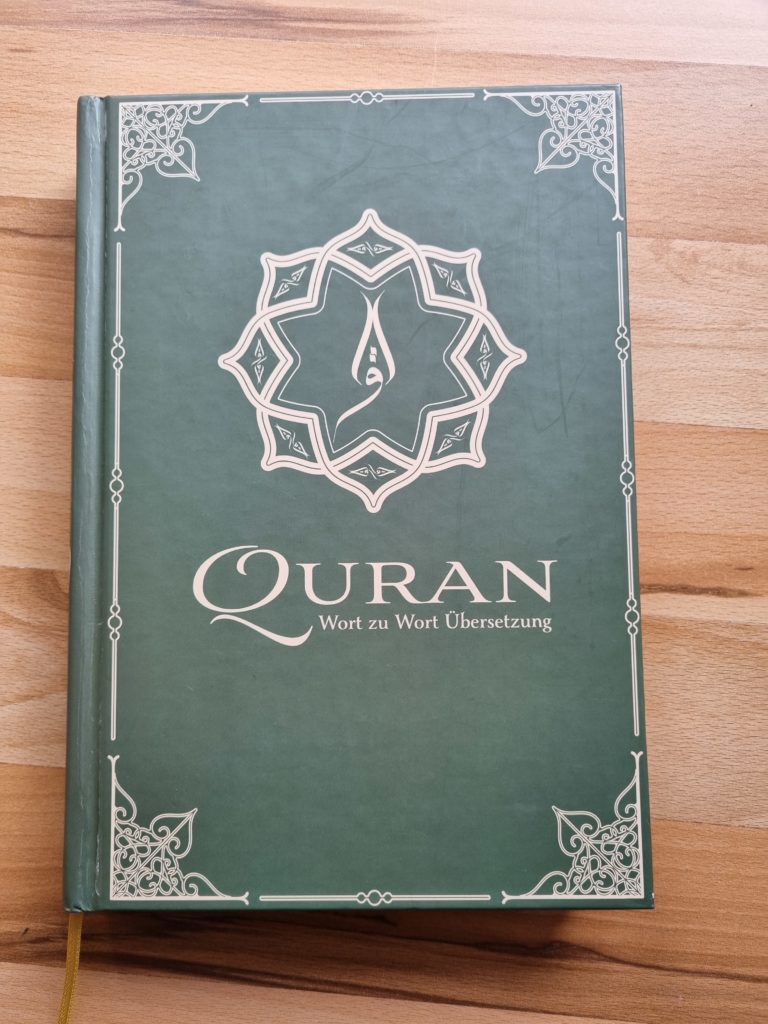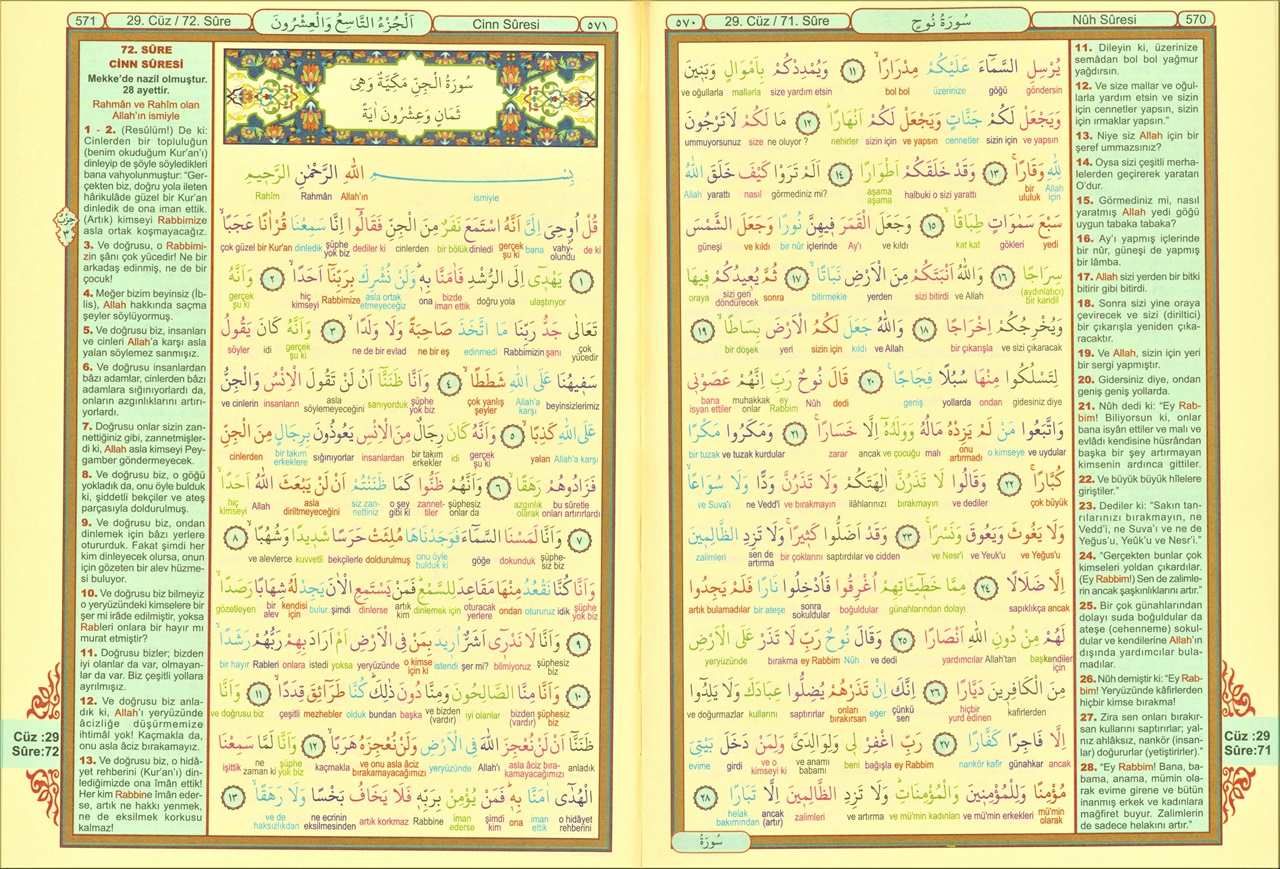In 2020, a nondescript self-publisher in Turkey issued a colour-coded interlinear word-for-word translation of the Qur’an into German with the (not very idiomatic) title Quran Wort zu Wort Übersetzung. Since it was the first of its kind, and still remains unique, it seems to have gained a certain popularity among German-speaking Muslims, especially those who are only just beginning to study the Qur’an. It is available from a number of online Islamic booksellers in German-speaking countries and also on Amazon’s German website.
This reflects a transnational development in the production and marketing of Qur’an translations. Throughout the twentieth century, Qur’an translations were usually framed as stand-alone texts that could be read by anyone without requiring them to consult the Arabic text. In recent years, however, there seems to be a resurgence of interlinear translations in many languages, which implies that the target audience is expected to recite the Arabic text of the Qur’an and follow its meaning, word for word. The Arabic muṣhaf is far more important in these translations than in the monolingual stand-alone translations or in bilingual edition in which the translation is printed as a stand-alone running text separate from the Arabic text. The interlinear type of Qur’an translation promotes a traditional Islamic mode of engaging with the Qur’an in a ritual manner, as opposed to the rather Protestant notion of studying a translation as an intellectual enterprise. Nevertheless, in modern interlinear translations, a running translation usually accompanies the interlinear version.


This is also true for Quran Wort zu Wort Übersetzung. The book contains a very brief (and again, not very idiomatic) German foreword by the editor, Abdulselam Tunç, and a thematic index that seems to be translated from Turkish, which results in a rather peculiar system of transliteration (for example, Abū Lahab is found as ‘Ebu Lahab’) and some incomprehensible lemmas such as ‘Obhut Allahs an die Propheten’ (roughly translatable ‘Allah’s custody towards the Prophets’). Tunç had previously published an interlinear translation with a completely identical layout in Turkish, which might explain some of the features of the German edition, such as the editors’ self-professed inability to use the German letter “ß,” which was probably unavailable in their layout software. The existence of a Turkish template might also explain some of the differences between the running and the interlinear translation.


According to the title page, the German Qur’an translations used are those by Abdullah as-Samit Frank Bubenheim and Nadeem Elyas (first published by the King Fahd Qur’an Printing Complex in Medina in 2001) and by Muhammad Rassoul (first published in Germany in 1986). As a matter of fact, the running translation in the margins of the page seems to be completely based on Bubenheim/Elyas. Rassoul’s translation plays no role here, and indeed it is not clear what role, if any, it has played in the book as a whole.
The interlinear translation, in many instances, faithfully follows the translation by Bubenheim and Elyas; it just breaks it up into segments and adapts it to the Arabic word order. But, in some cases there is a curious disconnect between the running and the interlinear translations.
For example, the syntactically ambiguous verse Q 2:2 (Dhālika l-kitābu lā ghayba fīhi hudan li l-muttaqīn) is translated with a different meaning in the interlinear translation and in the running text. The running translation, following Bubenheim and Elyas, has ‘Dieses Buch, an dem es keinen Zweifel gibt, ist eine Rechtleitung für die Gottesfürchtigen’ (‘This book, about which there is no doubt, is guidance for the God-fearing’).


The interlinear translation, however, gives ‘Dieses – (ist) das Buch – keinen Zweifel – (gibt es) darin – (es ist) eine Rechtleitung – für die Gottesfürchtigen.’ The meaning this brings across would be in English ‘This is the book. There is nothing doubtful in it. It is guidance for the God-fearing.’ The interlinear translators have thus broken down the verse into smaller syntactic units, and while doing so also changed the meaning from saying that the Qur’an cannot be doubted to saying that it contains nothing doubtful. The changes might not be theologically significant or exegetically indefensible, but they do contradict the running translation.
In other cases, there is a clear theological disagreement between the two translations even though they both figure on the same page. For example, Q 20:5 (al-raḥmānu ʿalā l-ʿarshi stawā) is translated by Bubenheim and Elyas fairly literally, in line with the doctrinal stance of the King Fahd Complex, as ‘Der Allerbarmer ist über dem Thron erhaben’ (‘The All-Merciful is exalted over the Throne’). The interlinear translation, however, replaces the translation of istawā as ‘erhaben’ (‘exalted’) with a metaphorical one, in rather ungrammatical, colloquial German: ‘Der Allerbarmer – (ist) über dem Thron – (ist) am Herrschen’, or ‘The All-Merciful – (is) over the Throne – (is) ruling’. This is one of the few occasions where there is a slight echo of Rassoul, who translated the verse as ‘(Er ist) der Allerbarmer, Der über Sein Reich majestätisch herrscht’; ‘(He is) the All-Merciful, Who majestically rules over His realm’.
In another instance, in Q 2:255, Bubenheim and Elyas translate God’s kursī as ‘Thronschemel’ (‘the Throne’s footstool’) in accordance with a hadith that the King Fahd Complex’s translations generally follow or at least mention, while both Rassoul and the interlinear translation just have ‘Thron’ (‘Throne’).
In a few cases, the interlinear translation deviates from Bubenheim’s and Elyas’s in a way that makes no sense in German whatsoever, for example the translators render Q 71:13 (mā lakum lā tarjūna li llāhi waqāran) as ‘Was – (ist) mit euch – nicht ihr wünscht – für Allah – Würde’, or ‘What – (is) with you – not you wish – for Allah – dignity’. In this instance, it is possible that they translated, or at least syntactically followed, the Turkish template on which the German translation is based (‘ne oluyor – size – ummuyorsunuz – Allah için – bir ululuk’). That Turkish translation, incidentally, is allegedly based on the translation by the famous late Ottoman and early Republican exegete Muhammed Hamdi Yazır Elmalılı, but it bears little relation to either his original wording or the translation that is commonly sold under his name. Rather, it seems to be a medley of popular Turkish Qur’an translations, which is quite typical of Turkish publishers’ lax attitude towards the authorship and copyright of Qur’an translations.

Based on these observations, it is not clear whether the producers of the interlinear translation in Quran Wort zu Wort Übersetzung had an agenda that differed from that of Bubenheim and Elyas, or whether their choices were simply arbitrary, reflecting a sloppy production process designed to turn out a profitable book. In any case, they seem to have identified a demand that reflects a desire to connect the study of Qur’an translations with the ritual practice of Qur’anic recitation.
Johanna Pink